
- Home Page
- Accepted
Paintings & Copies - Doubtful
Attributions - Doubtful Textual References
- Alternative
Titles - Collectors &
Museums - Bibliography
- Search Abecedario
- Watteau &
His Circle
X. Divertissement champêtre
Entered November 2014; revised February 2024
Los Angeles, Anthony Oganesian
Oil on canvas
65 x 81.5 cm
ALTERNATIVE TITLES
Fête galante
Le Vielleur
PROVENANCE
Paris, January 30, 1845, lot 5: “WATTEAU (ANTOINE) . . . Divertissement champêtre. Dans un parc, à l’ombre des arbres et au son de la vielle, deux amants en costumes simples et galants se livrent au plaisir de la danse, tandis que d’autres causent intimement à l’écart.” Sold for 285 francs.
Paris, Hôtel des ventes, December 10-11, 1847, lot 93: “WATTEAU . . . Danse au milieu d’un parc. Le joueur de cornemeuse est assis contre un piédestal, surmonté d’un vase; près de lui, debout, un joueur de musette, coiffé de rouge; à leurs pieds, groupe de deux enfants qui jouent avec un petit chien. C’est le centre de la composition.
A gauche, sur un fond de grands arbres au travers desquels on aperçoit une femme sur une balançoire, sont deux autres groupes: un berger tenant une houlette et embrassant une jeune fille vers laquelle s’avance un petit enfant; un homme, vu de dos, et étendu sur une draperie près d’une femme qui le regarde.
A droite, un homme, vu de face, en veste et culotte violette, danse, en tenant la main d’une femme vêtue d’un beau jupon jaune. Dans le fond, on aperçoit un groupe de cinq petites figures sous des arbres.
Cette charmante composition, analogue au tableau de M. le marquis Maison, en diffère cependant par le nombre de personages et les accessoires. Ici, nous avons de plus, le musicien debout, les trois enfants et la femme en robe jaune, à l’extrémité de gauche; c’est justement la figure qui accuse le mieux le style, la couleur et l’exécution de Watteau. Dans le tableau de M. Maison, on voit, au fond à droite, un troupeau de moutons et un clocher, remplacés ici par le petit groupe de personages.
Les arbres sont vivement peints en décoration, le ciel léger avec des nuages argentés; partou/t une belle pâte, une touche spirituelle et une couleur pleine de variété.”
Sold for 1000 francs.(?) Spain, private collection, prior to 1970.
Montevideo, sale, December 10-11, 1947, lot 93.
Geneva, private collection, c. 1972.
Florence, collection Luigi Grassi.
London, Sotheby’s, April 17, 1991, lot 53: “Follower of Antoine Watteau/ FETE GALANTE/ oil on canvas/ 65 by 81.5 cm.; 25½ x 32 in./ £10,000-15,000.”
London, Sotheby’s, December 8, 1993, lot 236: “Follower of Antoine Watteau / FETE GALANTE / Oil on canvas / 65 by 81.5 cm.; 25 ¾ by 32 in. / £10,000-15,000.”
Florence, sale, Galleria Panati Casa d'Arte, December 14, 2023, lot 89: “Attr. a Antoine Watteau / Festa campestre / Olio su tela / cm. 65,5x82/ Sul verso: etichetta Turquin, Paris, con n. 20.282. / Provenienza: ante 1970, Collezione privata, Spagna; 1972, Collezione privata, Ginevra; 1993, vendita Sotheby's, 8 dicembre, lotto 236, Londra. / Bibliografia: 1972, Jean Ferré Watteau Catalogue, Editions Artistiques Athena, Madrid, A 35. / Stima € 6.000,00 / 8.000,00."
SELECT BIBLIOGRAPHY
Ferré, Watteau (1972), cat. A35.
Cailleux, “A Strange Monument” (1975), 246-47.
Ferré, Watteau (1982), cat. P35.
Washington, Paris, Berlin, Watteau 1684-1721, under cat. P53.
Gétreau, "Watteau et la musique" (1987), 243-45.
REMARKS
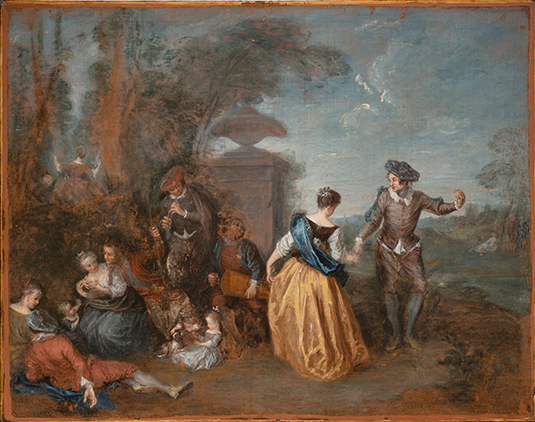
Anonymous artist, Divertissement champêtre.
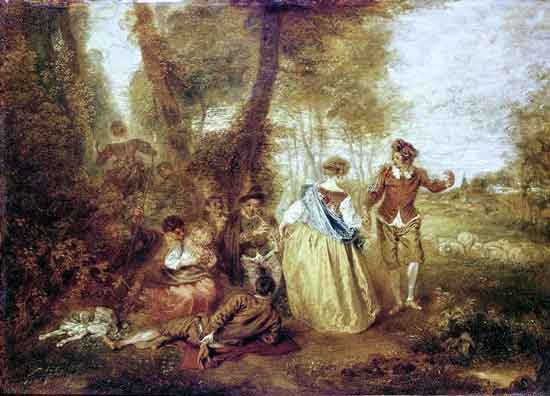
Antoine Watteau, Le Plaisir Pastoral, Chantilly, Musée Condé.
In mid-nineteenth century Paris, this painting passed as an autograph work from Watteau’s hand, as is shown by two newly discovered references in sale catalogues. Yet it then seemingly disappeared and it was apparently was unknown to Edmond de Goncourt and his contemporaries. In the twentieth century it was not cited by Dacier, Vuaflart, and Hérold, nor by Réau or Adhémar, nor by Macchia and Montagni.
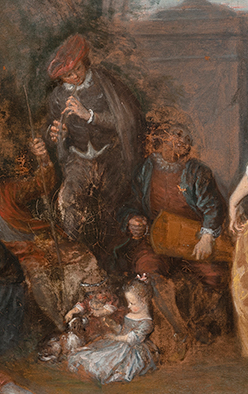
It remained hidden until it was discovered, supposedly in Spain, and Ferré brought it to public attention in 1972. He not only claimed that this was a painting by Watteau, but he maintained that the closely related version of the composition in Chantilly, Le Plaisir pastoral, was just a copy. That is an untenable position, especially because this picture is so markedly inferior to the Chantilly version. The vielle player at the center of Divertissement champêtre reveals everything. The expression on his face and his awkward contrapposto pose warn us against attaching Watteau’s name to the painting. Small details such as the urn atop the pillar also caution against Watteau’s authorship. Such garden adornments do not figure prominently in Watteau’s art (with the notable exception of the Fêtes vénitiennes) but they do appear in the work of his followers such as Lancret and Bonaventure de Bar. Not least of all, the Chantilly painting corresponds to the Nicolas Tardieu engraving in the Jullienne Oeuvre gravé whereas Ferré’s painting has no such supporting documentation.
Some of the differences between the two versions are telling in other ways, for they reveal the hand of a pasticheur. The dancing couple is essentially the same in both versions, save that the pasticheur has changed the color of the shepherd’s costume. At the same time, he reversed the directions of the other figures—the recumbent man in the foreground, the overly amorous couple behind, and the man pushing the woman on the swing. The recumbent man has been partnered with a seated woman, but it is an awkward juxtaposition, for as a result the man seems to be pressing or staring into his partner’s shoulder.
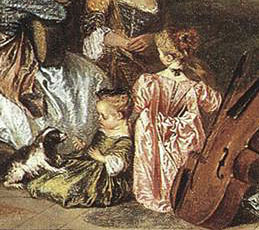
Antoine Watteau, Les Charmes de la vie (detail), London, Wallace Collection.
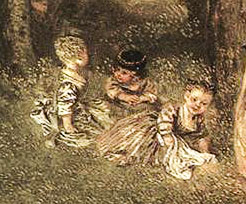
Antoine Watteau, Les Champs-Élysses (detail), London, Wallace Collection.
The pasticheur has also appropriated the figure of a child playing with a spaniel from another of Watteau’s paintings—either from Le Concert in Berlin or the closely related Les Charmes de la vie in the Wallace Collection. Also the spectral figures and landscape in the right background of Divertissement champêtre may have been inspired by the Wallace Collection painting. The child with a cap in Divertissement champêtre may be a variation of one in Watteau’s Champs Élysées.
The musicologist Florence Gétreau has advanced specific and pertinent doubts about the correctness of the representation of the music. She noted that both the horn and the hurdy gurdy are being played improperly, whereas Watteau was inevitably correct in depicting musicians performing. She also noted that the pairing of these two instruments is not a normal combination. Her conclusion was that the painting was not by Watteau.
In short, nothing argues in favor of the attribution of Divertissement champêtre to Watteau. It was outrightly rejected by Cailleux and other critics. As Rosenberg noted in 1984, its attribution to Watteau “has hardly been followed.” It is not mentioned, for example, by Roland Michel, Posner, Temperini, or Glorieux. At recent appearances at auction its attribution was sensibly downgraded to “a follower of Watteau.”
The recent cleaning of this picture by Luigi Grassi, as shown in our illustration above, has removed much of the overpainting and lets us see more clearly the hand of the painter. The evidence is now clearer than ever that the painting is not by Watteau; his true identity awaits to be discovered.